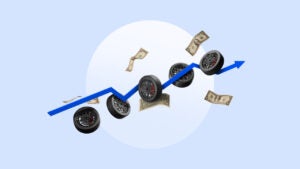How long are RV loan terms? And which is right for you?

Key takeaways
- Typical RV loan terms range from five years to seven, but this timeline may be shorter or longer, depending on the lender. Secured loan terms may exceed 12 years.
- Shorter repayment terms can help you save money on interest, but will result in a higher monthly bill. Longer repayment terms offer a more affordable payment, but you’ll pay more on interest over time.
- The best repayment term for your loan will be determined by factors, such as your finances and credit score, as well as the RV model you choose.
Typical RV loan terms last between five and seven years, but you could find shorter or longer terms, depending on your lender. Term length is the second biggest factor in determining the cost of an RV loan, after interest. A long term may be tempting to keep monthly payments as low as possible, but it may result in paying thousands — or even tens of thousands — more over the course of your loan.
Typical RV loan terms
RV financing terms typically last two to seven years. That said, you can still find RV loan terms as long as 20 years. It all depends on the overall cost of the vehicle, your finances and the lender you work with.
Longer financing timelines (15 to 20 years) tend to be limited to larger RV models. That’s because some RVs can be in the same price range as a small house. Many buyers need a financing timeline similar to that of mortgage products.
Learn more: Should you buy or rent an RV?
Factors that affect your RV loan terms
Several factors impact the RV financing terms you receive, including the type of RV, loan amount, monthly payment, type of lender and your credit score.
- Loan amount. The length of your RV loan term generally depends on the size of your loan. Lenders typically limit longer RV financing terms to larger loan amounts. However, this all depends on loan sizes offered by your lender and your qualifications.
- Your credit score. The term also depends on your credit score because this shows lenders how likely you are to repay your loan. The higher your credit score, the more likely you are to qualify and the longer term length options you’ll get offered. A good credit score is considered between a 670 and 730 FICO score. With a lower score, lenders may see you as a higher risk and offer shorter term lengths.
- RV condition and age. Just like cars, RVs depreciate with time. In fact, some models’ value can decrease by more than 25 percent in just the first three years of use. Lenders often restrict term lengths and amounts based on the model’s age to mitigate risk. Buying new or used and any RV features that may affect the price are also considered.
- Type of lender. Dealerships often offer longer repayment terms than personal loan lenders, like banks, credit unions and online lenders. These lenders offer terms ranging from two to seven years. Meanwhile, dealerships may offer repayment terms of up to 20 years, making them a better option if you plan on buying new.
- Your desired monthly payment. A longer repayment term often results in a lower monthly payment. However, this also translates to more interest paid over the life of the loan than if you chose a shorter repayment timeline. Use a loan calculator to check your monthly loan payment to see if it is an affordable option for you.
How to choose the right length of your RV loan
A shorter term results in spending less on interest overall but more each month, while a longer term long may have a less expensive monthly payment but cost more in interest.
The longer your repayment term, the more interest you will pay over the life of the loan — even with a lower rate. For example, a 7.99 percent interest rate on a $50,000 RV loan will cost over $16,000 more for a 10-year term versus a three-year term.
|
Monthly Payment |
Total Interest |
|
|
3 years |
$1,567.00 |
$6,397.15 |
|
5 years |
$1,014.00 |
$10,814.83 |
|
7 years |
$779.00 |
$15,441.18 |
|
10 years |
$606.00 |
$22,764.86 |
Loans with higher interest rates will result in a much larger difference. A $50,000 loan with a 17.99 percent interest rate will cost you around $15,000 in interest over the course of three years. If you bump your term up to seven years, you’ll wind up paying over $38,000.
Choosing a longer term can be beneficial if you’re financing an expensive model. It can make your monthly payments more manageable. Likewise, stretching the loan term can be smart if you need extra wiggle room in your budget.
That said, RVs depreciate in value just like cars. Choosing a longer repayment term could mean more comfortable payments, but it can also put you at risk of having an underwater loan. That means having negative equity because you owe more than the asset is worth.
If that happens, you may have a hard time refinancing the loan. You will also struggle to sell the RV for enough money to cover your remaining debt, should you need to.
How to finance an RV
To get an RV loan, you should check your credit and prequalify with different lenders so you can get the best terms for your purchase.
- Check your credit. Knowing your credit score will help you choose the right lenders to apply with, as each lender has different credit requirements for approval. That said, the higher your score, the better terms and interest rates you can secure.
- Compare lenders. To secure a reasonable monthly payment at a low interest rate, compare RV loans. This allows you to estimate your monthly payment and see the loan terms you are eligible for.
- Prequalify. Once you have a few lenders you like (at least three), see if they offer prequalification. Prequalifying for an RV loan is a quick way to preview available rates and terms without impacting your credit score. To get started, you fill out a quick application with details including your name, estimated annual income, monthly rent or mortgage payment, Social Security number and date of birth.
Once you have prequalified, you are ready to buy your RV. Since you likely already know what type of RV you want to invest in, prequalifying for a loan gives you an extra edge during negotiations when you visit a dealership.
Bottom line
RVs are depreciating assets, which means they lose value over time — just like cars and trucks. If your loan term is too long, you may become underwater on your loan. And owing more than your RV is worth may put you in a difficult financial position.
That’s why you should always choose the shortest repayment term that comfortably fits your budget. This may require you to recalibrate your budget or opt for a less expensive model, but it will be worth it to avoid overpaying in the long run.
You may also like

What is multiyear approval for student loans?


What’s the average car loan length?




